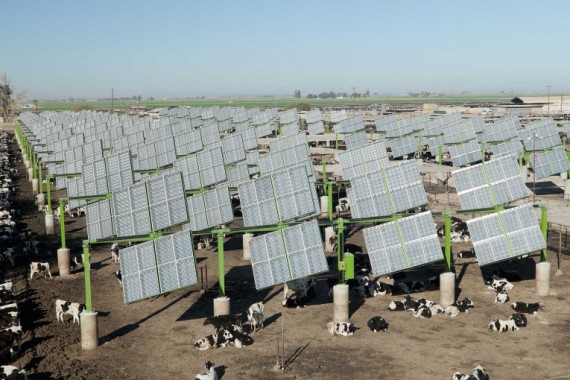Four Things The Farm Bill Could Do For Clean Energy

America’s agriculture is highly dependent on specific, stable climate conditions. Yet global warming is wreaking havoc on our nation’s farmlands — an industry that produces nearly $300 billion per year in commodities. The frequency and severity of droughts, floods, and changes in precipitation are having negative effects on crops.
It’s only going to get worse. According to the U.S. Climate Assessment, the future holds far more devastating droughts, more floods and more heat waves — resulting in the further decline of crops and livestock production. An effective strategy to protect America’s agricultural sector will have to involve both climate change mitigation and adaptation practices.
Indeed, Mark Hertsgaard wrote last year in The New York Times, “The farm bill is not only the centerpiece of United States food and agriculture policy, it is also a de facto climate bill.”
This year, Congress has another chance to shape the legislation to effectively combat climate change and help farmers prepare for what we know will occur on our farmlands. Last year, Congress was only able to extend the farm bill through September 30, 2013.
Despite modest energy provisions, neither the House or Senate versions of the farm bill comes close to preparing the American agriculture industry to adapt to the devastating effects of climate change.
Clean energy provisions play a relatively minor role in both farm bills, receiving zero mandatory funding in the House version and about 11 percent of the Senate bill’s direct outlays over the next five years. Both bills pursue mitigation through programs for renewable energy and efficiency, but they overlook the other vital arm of a thorough climate change response: adaptation.
By overlooking adaptation policies in the 2013 farm bill, both chambers of Congress are missing an opportunity to protect American farms from further damage from climate change at a time in which action is increasingly important. What’s worse, the five-year time frame of typical farm bills will delay Congressional action on adaptation until 2018.
While neither bill is capable of adequately defending agriculture from climate change risks, the Senate bill comes much closer to doing so than its House counterpart. The Senate bill re-authorizes more energy programs and contains higher funding levels than the House version. As stated earlier, H.R. 6083 gives no mandatory funding to existing clean energy programs and would be the first farm bill of this century to do so if it becomes law.
S.B. 954, on the other hand, includes $615 million of mandatory energy funding over the next five years. The lack of direct spending in the House version puts important agricultural energy programs at risk of losing the funding they need to combat climate change.
The majority of farm bill energy funding goes to the following four programs:
•The Rural Energy for America Program (REAP), first authorized in the 2002 farm bill, provides grants and loan guarantees to farmers and rural small businesses for installing renewable energy and increasing efficiency. REAP has funded 7,000 projects that have cut emissions by more than 2 million metric tons, produced 6.5 million MWh of energy, controlled energy costs, reduced reliance on fossil fuels, leveraged private investment and created or saved thousands of jobs.
•S.B. 954: authorizes REAP with $252 million of mandatory funding over the next five years
•H.R. 1947: gives REAP $225 million of discretionary funding over the next five years
•The Biomass Crop Assistance Program (BCAP) helps farmers establish, produce and deliver biomass feedstocks by matching payments for energy crops. BCAP has been efficiently reformed and is projected to generate $88.5 billion in economic activity by 2023.
•S.B. 954: provides $94 million of mandatory funding over the next five years
•H.R. 1947: cuts payments for collection, harvest, storage and transportation of energy crops and authorizes $75 million annual discretionary funding through 2018
•The Biorefinery Assistance Program (BAP) promotes the production of advanced biofuels by helping biorefineries make the difficult leap to commercial scale. Through loan guarantees and grants, BAP has provided funding to many “first of its kind” biorefinery technologies.
•S.B. 954: provides $176 million of mandatory funding over the next five years
•H.R. 1947: eliminates grant funding for demonstration projects and authorizes a maximum of $75 million of annual discretionary funding over the next five years
•The Biomass Research and Development Initiative (BRDI) funds research, development and demonstrations projects for feedstocks, biofuels and biobased products.
•S.B. 954: maintains comparable funding levels, averaging $26 million of mandatory funding per year through 2018
•H.R. 1947: provides $20 million of annual discretionary funding
These four existing programs are important drivers of a clean energy transition in the agricultural sector, and passing the Senate version is the best option for ensuring their ongoing success. It is important to keep in mind, though, that mitigation policies are only half of a solution. Congress must also enact adaptation policies to protect the agricultural sector from bearing the brunt of climate change.
You can return to the main Market News page, or press the Back button on your browser.

